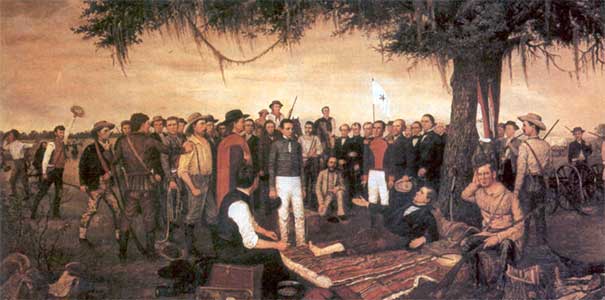
RUN FOR YOUR LIVES!
By Bob Jamison
Paul Revere wasn’t the only one to sound the alarm of impending danger and possibly death by torturous acts. There was another famous person in Texas that brought the sound of war close to home. Naturally, his hasty travels from the Alamo to East Texas were intended to save many lives of helpless settlers. This event was known as the Runaway Scrape.
Under the orders to alert Samuel Adams and John Hancock in April 1775 that the British were dispatched to arrest the two patriots, Revere rode through the night on borrowed horses to save these heroes of the Declaration of Independence. While performing this desperate mission, he warned country side that: “The British were coming!”
Upon riding up to Adams’ home, an armed guard challenged Revere to stop making such a noise. He replied, “You are going to hear more noise than I can make when the British arrive here shortly. Now stand aside!”
Sixty one years later, Juan Seguin was ordered to join William B. Travis at the Alamo. He joined Travis, Bowie, Crockett and the other heroes to defend Texas against the onslaught of the huge Mexican army under the personal command of a blood thirsty president, Santa Anna. Travis had intelligence of the futility in the battle against such odds, and ordered Seguin to run through enemy line and notify Fannin at Goliad for his assistance. However, the same fate was in store for Fannin.
Travis knew well what was likely to happen if help did not arrive. In fact, General Sam Houston dispatched an order to Travis and one to Fannin to abandon their post and retreat from the Alamo and Goliad. Both refused and stayed to fight for the honor of Texas. Travis drew his sword and made a line in the sand and invited anyone to leave to avoid what appeared to be certain death. They stayed.
Juan Seguin met up with General Houston and described the circumstances as he knew them to be. Houston told him to gather his band of vaquero volunteers and warn the scattered settlers of what lies ahead. For this service, Sequin was soon to earn the title, “The Paul Revere of Texas.” With that accomplished he would return to San Jacinto to join in the continued battle for independence, which he did.
His warning, with the Mexican army on his heels, caused settlers to flee eastward leaving most everything they could not easily carry. Chickens, horses, cattle and even their loyal dogs were left to fend for themselves. The families left on wagons and horses or afoot to flee. They crossed dangerous swollen rivers and fought the elements of spring rains and other dangers. Some could hear the cannon fire by the “Twin Sisters” at San Jacinto as they came eastward nearer to the battlegrounds.
When many arrived from the westward movement at Washington on the Brazos, Secretary of War, Colonel Rusk stationed soldiers to observe the crossing there and any man with a rifle was detained to help further defend against the Mexican approach. Then Rusk joined Sam Houston on the Brazos and then on to San Jacinto. Again, he repeated many times in the solicitation of able fighting men to join in the impending fight.
Unfortunately, all that were to join the warning effort were not the patriots we would like to remember during the Runaway Scrape. Some ruthless opportunist saw the lure of gaining wealth by gathering stock and valuables left behind as a result of their own warning of the Mexican advance.
As the refugees traveled farther eastward, they approached the flooded Trinity River near Dayton. The Old Spanish Trail, now called U. S. Highway 90, was to meet the flood waters of the river at likely the widest place. That would be Dayton Hill where the historical marker exists today. However, logic would dictate that the crossing did not occur at that spot. The suggestion that the trace of the OST followed the hill lines northward above the river bottom flooded land. Possibly, it followed what is now FM Hwy l008 to Kenefick, Texas.
From an airplane, one can easily see why. The evergreen pine trees grow only on land that does not frequently flood. Therefore, the contrast of the dark green pines versus the lighter colored trees should indicate that the high ground is very close to this highway. As it reaches FM Hwy 2797 the trace should turn eastward to the river.
At this point, the high ground is on the west side of the Trinity allowing floating rafts to carry people to high ground on the east side by the shortest distance. This would appear to be approximately just north of Travis Park subdivision in Liberty and near Governor’s road or the home of former Governor and Mrs. Price Daniel.
Reports indicate that while waiting for river crossing rafts to return from the east high ground, word came that Sam Houston had won and Texas was free. They returned to their respective homes and what there was left was joined with the blessing that their lives had been saved.